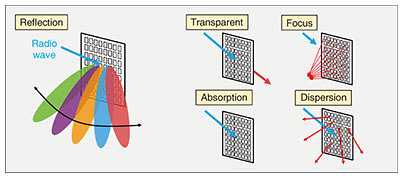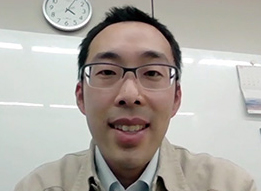 |
|||
|
|
|||
|
Rising Researchers Vol. 20, No. 4, pp. 6–9, Apr. 2022. https://doi.org/10.53829/ntr202204ri1  Research on Intelligent Reflector Control and Wireless Sensing for Intelligent Radio-wave Design TechnologyAbstractAs we move toward the era of the Innovative Optical and Wireless Network (IOWN), intelligent radio-wave design technology is expected to usher in a paradigm shift from provided transmission spaces to created transmission spaces. In this article, we speak to Distinguished Researcher Tomoki Murakami about the two technologies that underpin this technology. Keywords: intelligent radio-wave design, intelligent reflector control, wireless sensing The two technologies that underpin intelligent radio-wave design technology—What exactly is intelligent radio-wave design technology? Previous research on wireless technologies has generally focused on achieving high-speed communications in a provided wireless transmission space. In contrast, intelligent radio-wave design technology is a research concept that aims to maximize transmission quality and speed by changing the wireless transmission space itself in accordance with its surroundings, controlling the direction and strength of radio waves. Using our smartphones as an example, we have thus far improved mobile terminals and base stations to aim for even faster communications by making use of the radio waves that are constantly transmitted from base stations to mobile terminals. In contrast, the intelligent radio-wave design technology being proposed can enable us to provide a better Internet infrastructure and networked environment by recognizing the wireless environment of the city itself in real time and dynamically changing the direction of the radio waves using devices scattered throughout this space, thereby allowing radio waves to reach places they could not reach before. As data traffic increases and as we enter into the era of Internet of Things and the Innovative Optical and Wireless Network (IOWN)—where not only people, but things also communicate—communications is becoming increasingly important. We have therefore established a group whose main mission is to establish intelligent radio-wave design technology, aiming for a high-quality, connected world, even when networked environments change. There are various ways of designing an intelligent radio wave, for example, having radio waves received and their signals processed at relay stations. However, today I would like to tell you about two underlying technologies that I am involved in: intelligent reflector control and wireless sensing. —What exactly is intelligent reflector control? Reconfigurable intelligent surfaces (RISs) are reflectors made from special materials that change the electrical characteristics of radio waves. Their reflective characteristics such as their angle of reflection and transmissivity can be altered by electronically controlling each element. When reflecting light with a mirror, the angle of incidence light is equal to the angle of reflection light. But with RISs, the direction of the reflected radio wave can be changed as the angle of reflection can be controlled at will. As an example, this means radio waves can be made to reach places they could not previously reach with conventional reflectors due to shadows cast by obstacles. It is also now possible to focus radio waves to specific points to improve transmission quality. In addition, we can now also transmit radio waves directly through and behind reflectors, absorb them so that they do not reach anywhere, or disperse them over a wide area, as detailed in Fig. 1.
We are conducting research on the technologies that control these RISs. We have been conducting a joint experiment with NTT DOCOMO on the effect of RISs on 5G (fifth-generation mobile communications system) radio waves, which we announced in a press release in November 2021 [1]. At present, we are focusing our research and development on collaborative-control technology for multiple intelligent reflectors, with the aim of further improving transmission quality. —What is wireless sensing? In order to design intelligent radio waves, it is essential to understand the shape of the real space and its radio environment—in other words, sensing technology is essential. It visualizes information acquired through sensing and previously collected big data, analyzes it using machine learning, and then feeds this all back to RISs that alter the space. Since 2020, I have also been working at NTT Network Innovation Laboratories, where I am conducting research into spatial recognition through sensing that combines various types of media, such as cameras. Within this, wireless sensing is comparatively easy to achieve using specialized equipment and dedicated apparatus. However, our research aimed to do this in an affordable way, and to obtain various kinds of information using existing wireless apparatus. The key is using such information for purposes other than communications. From signal strength, we can obtain information such as the location of mobile terminals, whether there are people around and how crowded it is, and whether a door is open or closed. We actually set up a Wi-Fi router in our meeting room, first had a system learn what the room was like when people were in it, and then took measurements, and we found that we were able to detect with a high accuracy of around 95%. As we move toward the IOWN era, we hope that we will be able to develop new markets by expanding our wireless systems to areas other than communications. Intelligent radio-wave design technology will usher in a paradigm shift—What are your plans for future research? Intelligent reflector control has currently only been evaluated indoors in a single environment. Going forward, we would like to roll it out outdoors and test its effectiveness in an actual environment. Compared to indoors, where there are fewer moving objects, the outdoor environment changes a lot with many moving objects, such as vehicles that can affect the radio waves, so we expect that control will be difficult. At present, we are experimenting with a single reflector surface, but we would like to do testing on the use of multiple reflector surfaces as well. In order to obtain information from multiple reflector surfaces and control them individually, we need to consider what to do about control signals. While there are still a number of issues to be resolved, we believe that we will be able to achieve even greater results in terms of transmission quality. Furthermore, I want to get started on the development side of our research, for example implementing it at an actual base station. In the future, we hope we will be able to provide a high-quality, uninterrupted environment through the collaborative control of intelligent reflectors positioned in various places. We have already paved the way for the implementation of wireless sensing, and are now considering the possibility of introducing sensing functionality to existing base stations. There are always obstacles to overcome when creating something new, but there are no such obstacles if you use something that already exists, so testing can be done relatively quickly. By finding and calling attention to use cases over the next few years, we hope we can create a world in which sensing functionality becomes entirely commonplace. —What kinds of possibilities will intelligent radio-wave design technology unlock? In the IOWN era, as services and applications become more and more diversified, the requirements of wireless networks will also become more diverse. They will need to be more reliable and have lower latency, rather than simply having higher speeds. The implementation of intelligent radio-wave design technology will have various effects such as higher data transmission speeds, increased transmission coverage, reduced latency, and lower packet loss. This will be a paradigm shift from provided wireless transmission spaces to wireless transmission spaces that we create. I truly think this has incredibly vast potential. Currently, some environments cause frustrations such as connection difficulties and time lag, but I believe that this will no longer be the case in the future, as we will be able to freely use wireless transmissions unbound by environment or application. I believe that this technology will form a foundation for providing better services to customers. —Is there anything you would like to say to young researchers and future business partners? NTT Access Network Service Systems Laboratories not only creates new technologies, but also places a great deal of importance on the commercialization of these technologies, which means providing them to the world in the form of specific products and services. It would make me happy and give me great satisfaction to be able to show something to my own children and tell them that their father made it. In terms of external partnerships, I think the most important thing is that we have been able to conduct joint research on sensing technologies. Initially, we had the wireless communications technology, but we lacked knowledge and expertise when it came to sensing. Therefore, we collaborated with companies in different fields on this by having them use the wireless sensing equipment we developed and conduct research and development of various technologies side-by-side, which really helped propel our efforts forward. As we created a system that could measure radio waves using commercially available equipment, we have been able to collaborate with many joint research partners, and as a result, we have been able to significantly expand the scope of this technology. We believe that conducting joint research with companies in different fields, rather than in the same communications field as us, gives us greater potential and greater effectiveness in terms of the new things that can be created. We have a diverse range of research collaborators in fields such as information processing, agriculture, materials, and heavy machinery, and we would like to continue collaborating in a variety of areas in the future. With toys as an example, there are things like radio-controlled cars that use wireless technology in a very simple way. However, there are not many products that use the latest wireless technologies. There may be some issues in terms of cost, but I believe that even more fun and interesting products could be created. I would like those involved in research at their company to be aware of the fact that some research and development is unique to their company. At universities, I think academics are involved in some really cutting-edge research in certain fields. However, I think companies need to focus on how they can contribute to society by actually providing tangible products. I would like to encourage any of our future business partners to utilize our basic technologies for IOWN by conducting research and development together with us. We will be working hard to create new products and services, and are looking forward to working together.
Reference
■Interviewee profileTomoki Murakami joined NTT in 2008 as a master’s graduate, working at NTT Network Innovation Laboratories. In 2015, he moved to NTT Access Network Service Systems Laboratories and subsequently obtained his Dr.Eng. from Waseda University. He was awarded the IEEE (Institute of Electrical and Electronics Engineers) AP-S Japan Chapter Young Engineer Award in 2014 and the ARIB (Association of Radio Industries and Businesses) Radio Achievement Award (The Prize of the Minister of the Ministry of Internal Affairs and Communications) in 2020 while working at NTT Network Innovation Laboratories. |
|||










